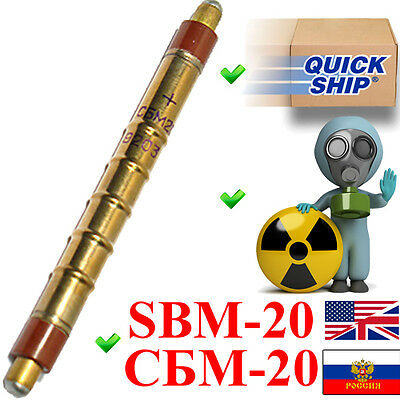-40%
Precision Radiation Instruments Model 111B DeLuxe "Scintillator" sold "As Is"
$ 60.72
- Description
- Size Guide
Description
Precision Radiation Instruments Model 111B De Luxe"Scintillator"
Sold "As Is"
The Precision Radiation Instruments Model 111B was one of the earliest commercial NaI survey meters designed mainly for uranium prospecting. It employed an eye-catching chrome finish not too different from the automobiles of the 1950s.
The Model 111B seems to have first appeared in 1954.
This
DETECTOR
consists of two (2) separate parts, which are connected by a cable. The portion that contains most of the electronic components and the detecting element is the
PROBE
. It houses a 1.5" x 1 " Sodium Iodide (NaI) crystal, which is very dense, as a detecting element, shown in the 6th exhibit. The crystal responds to practically every gamma ray that strikes it, whereas Geiger Mueller (GM) tube reacts to less than 1% of the gamma rays than penetrate it. This makes the Scintillator a more sensitive instrument than the Geiger Mueller counter.
For ease of operation, this comes with only two (2) main controls, the
RANGE
and the
TIME CONSTANT
switches. It employed six (6) ranges: 0-0.025, 0-0.05, 0-0.25, 0-0.5, 0-2.5 and 0-5 mR/hr as well as
OFF
and
ZERO
. The use of the Time Constant control is as follows: one of three (3) positions can be selected by turning the knurled knob to
FAST
,
MEDIUM
or
SLOW
. The
ZERO
control is one of two controls covered by cap nuts. The meter can be electronically zeroed with this control by first turning the MR/HR range control to zero. The scale also indicated the percent uranium content ore - in fact, it was the first instrument to employ such a "percent meter". While it was designed to permit aerial, motor vehicle and foot surveys, it was primarily employed as a hand held meter. The
CALIBRATION ADJUST
control is also covered by a cap nut. It's used to compensate for changes in vacuum tube amplification as the batteries wear out. A locked adjustment on the top of the unit permitted the surveyor to adjust the calibration in the field. A 1.25" coin-shaped check-source is provided (
usually a source of depleted uranium)
having
an intensity of 0.10 mR/hr
that's
stowed in a slot attached to the battery box as shown in the 5th exhibit,
Just for the record, the two (2) red and black tip jacks marked
RECORDER
located between the
CALIB ADJ
. and
ZERO ADJ.
cap nuts can be used with a continuous strip recorder as shown in the 4th exhibit. However, their electrical output is not sufficient to operate a recorder directly. In order to increase the output to a level sufficient to drive a recorder, it's necessary to use a pre-amplifier. This is
NOT INCLUDED.
The other part of this detector is the
BATTERY BOX
which contains the batteries. The probe attaches to the battery box with a snap catch. The probe can be separated from the battery box by releasing the snap fastener on the top of the battery box. The probe may then be placed in any position that will offer greater sensitivity. For ease of operation, the battery box can be attached to the surveyor's belt as shown in the first two (2) exhibits. This detector was powered by two (2) 67.5 volt batteries (Eveready #467 or equivalent NEDA 203), two (2) 22.5 volt batteries (Eveready #412 or equivalent NEDA 215)
and four (4) 1.5 volt type "D" flashlight cell batteries
(Eveready #D99 or equivalent)
ALL NOT INCLUDED
.
The original Eveready #455 and #412 carbon-zinc batteries are no longer available, however, they have become available as alkaline through another brand, Exell battery. I've seen them on sale on-line (e.g. Lowe's.)
This is a relic of the Atomic Age, circa mid 1950s and
is mainly a "museum" or "conversation" piece.
The survey meter as a appears to have some minor outward cosmetic wear mainly from use and age. This survey meter was tested with the necessary batteries and when powered-on, the needle on the meter would move slightly from the zero position and no response when exposure to a radioactive source.
It would take a "
Radio Shack
" type to restore/upgrade this survey meter, but not entirely impossible, mainly due to its some-what simplistic design as compared to today's micro-chip technology.
The survey meter comes with a cowhide carrying case and a
facsimile of the
Operation and Maintenance Manual
shown in the last exhibit.
Made by Precision Radiation Instruments, Inc. Los Angeles, CA Serial No. 111TTB9558
Visit my eBay Store


















